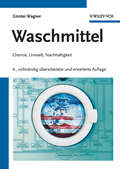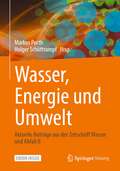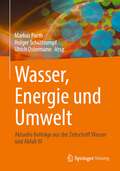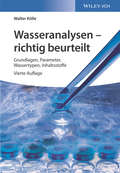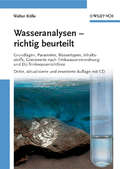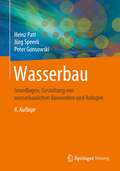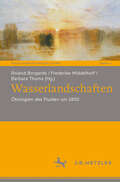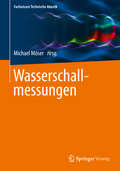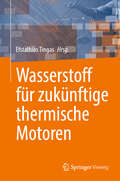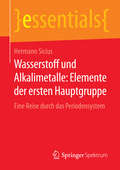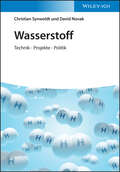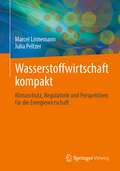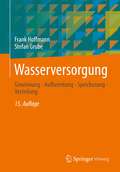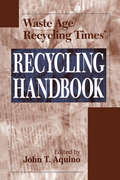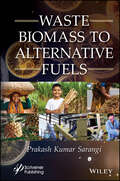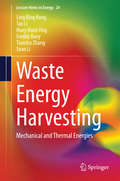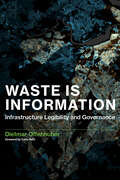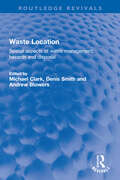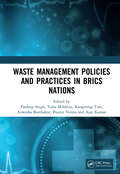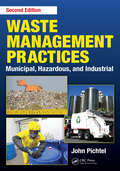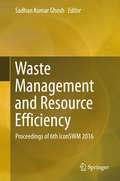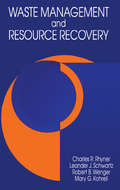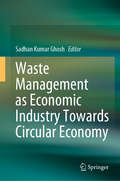- Table View
- List View
Waschmittel: Chemie, Umwelt, Nachhaltigkeit
by Günter WagnerEnvironmental awareness in Germany is closely linked to washing powder. The mountains of foam in many rivers during the hot summer of 1958 showed how Western lifestyles were incompatible with the environment: the surfactants in washing powder were biologically upgradeable or, at best, hardly degradable. This played a large role in creating environmental consciousness and in strengthening research into washing powders. Here the author disseminates the chemical, biological and physical knowledge behind modern washing processes to all interested parties; schools, students, and lab workers; to all who need, use and - above all - pass on this knowledge: teachers, trainers, lecturers, consultants, professional associations, consumer agencies, societies, government agencies and other private or state-run institutions will appreciate this detailed, yet readily comprehensible source.
Wasser, Energie und Umwelt: Aktuelle Beiträge aus der Zeitschrift Wasser und Abfall II
by Markus Porth Holger SchüttrumpfIn diesem Band werden unter anderem Handlungsempfehlungen für die Überflutungsvorsorge gegeben, die Hebung des energetischen Potenzials von Abwasser besprochen und Praxisbeispiele zur ökologischen Sanierung oder ökologischen Baubegleitung dargestellt. Er umfasst die kommunale Abwasserbehandlung, Energiegewinnung aus Abwässern, Diskussionstand zu Mikroschadstoffen in Gewässern sowie deren Ökosystemfunktionen und Klimaanpassungsstrategien.
Wasser, Energie und Umwelt: Aktuelle Beiträge aus der Zeitschrift Wasser und Abfall III
by Markus Porth Holger Schüttrumpf Ulrich OstermannWie die beiden erfolgreichen Vorgänger fasst auch der 3. Band „Wasser, Energie und Umwelt“ ausgewählte Beiträge aus der Zeitschrift Wasser & Abfall zusammen. Ein besonderer Schwerpunkt dieses Bandes liegt auf dem Hochwasser im Juli 2021 in Nordrhein-Westfalen und Rheinland-Pfalz. Untrennbar verbunden mit diesem Ereignis sind die Themen Starkregen und Hochwasserschutz sowie die Beteiligung von Stakeholdern. An wasserwirtschaftlichen Themen schließen sich die Umsetzung der Wasserrahmenrichtlinie im Hinblick auf Gewässerökologie und Gewässerstruktur an sowie Nutzungsdruck auf die Gewässerkörper, Trockenheit und Anpassungen an den Klimawandel.Der Band widmet sich aber auch Aspekten zum Umgang mit Ressourcen und der Kreislaufwirtschaft. Beispielhaft seien die Bereiche Mikroplastik und Kunststoff sowie die Klärschlammbehandlung zum Boden- und Grundwasserschutz, aber auch zur Rückgewinnung von Dünger und mit dem Effekt der Verminderung einer Abhängigkeit von dritten Rohstofflieferanten genannt.
Wasseranalysen - richtig beurteilt: Grundlagen, Parameter, Wassertypen, Inhaltsstoffe
by Walter KölleFür eine sichere und nachhaltige Trinkwasserversorgung muss die Qualität von Trinkwasser wie auch von Rohwässern ständig mithilfe immer komplexerer Wasseranalysen überwacht werden. In dieser vollständig überarbeiteten und an die aktuelle Trinkwasserverordnung angepassten Neuauflage seines Klassikers bietet Walter Kölle anhand von zahlreichen Beispielanalysen einmal mehr einen umfassenden Überblick über wasserchemische Grundlagen, die Relevanz verschiedener Messgrößen für die unterschiedlichen Wassertypen, das Vorkommen von natürlichen und anthropogenen Wasserinhaltsstoffen, sowie praktische Hinweise zur Berechnung und Auswertung von Analysedaten. Die in Deutschland und in der EU gültigen Grenzwerte gemäß Trinkwasserverordnung und Europäischer Trinkwasserrichtlinie werden durchgehend berücksichtigt. Zahlreiche Parameter wurden neu aufgenommen, beispielsweise Arzneimittel, Bauchemikalien, Süßstoffe, Phthalate und Mikroplastik. Ein besonderes Augenmerk gilt der der Calcitsättigung und ihrer Bedeutung für die Trinkwassernutzung sowie ihrer Berechnung nach der neugefassten DIN-Norm. Auf der zugehörigen Webseite findet der Leser umfangreiches ergänzendes Bildmaterial u. a. zu den Reaktionspartnern des Wassers im Grundwasserleiter, zur Wasseraufbereitung, zu Biofilmen, Korrosionsprodukten und Asbest. Ein unverzichtbarer und in der Praxis bestens bewährter Leitfaden für jeden, der beruflich mit der Überwachung der Wasserqualität zu tun hat.
Wasseranalysen - richtig beurteilt: Grundlagen, Parameter, Wassertypen, Inhaltsstoffe, Grenzwerte nach Trinkwasserverordnung und EU-Trinkwasserrichtlinie
by Walter KölleDer Bestseller von Walter Kolle hat sich inzwischen einen festen Platz in Laboratorien, Hochschul- und Forschungsinstituten, Ingenieurburos, Wasserwerken und Aufsichtsbehorden erobert. Der Leser wird - auch ohne dass er vertiefte chemische Vorkenntnisse mitbringt - in die Grundlagen der Wasserchemie eingefuhrt und erfahrt alles Wissenswerte uber die Inhaltsstoffe des Wassers und deren Beurteilung nach Ma?gabe der aktuellen Gesetzgebung. Die wasserchemischen Zusammenhange werden anhand von 29 Analysenbeispielen, zahlreichen Tabellen und einem umfangreichen Glossar erlautert. Die Wasserchemie ist in einem Wandel begriffen, der sich immer mehr beschleunigt. Mit der dritten Auflage des Buches wird dieser Entwicklung Rechnung getragen. Zahlreiche neue Parameter werden ausfuhrlich diskutiert. Ebenso werden die Anderungen erortert, die mit der geplanten Neufassung der Trinkwasserverordnung zu erwarten sind. Uberall, wo Wasser flie?t - sei es in der Natur, im Wasserwerk oder in den Rohrleitungen der Kunden - werden anorganische und organische Stoffe umgeschichtet. Der Autor hat Reaktionspartner und Reaktionsprodukte des Wassers fotografisch dokumentiert und stellt das Bildmaterial zusammen mit detaillierten Erlauterungen auf CD-ROM zur Verfugung
Wasserbau: Grundlagen, Gestaltung von wasserbaulichen Bauwerken und Anlagen
by Heinz Patt Peter Gonsowski Jürg SpeerliMit dem bewährten Nachschlagewerk für den projektierenden Bauingenieur ist das Basiswissen für den konstruktiven Wasserbau im Binnenland immer zur Hand. Studierende des Bauwesens führt das Buch in die Grundlagen des Wasserbaus und der Wasserwirtschaft ein. Die Ausführungen zum Feststofftransport, zur Gewässerbettdynamik und zur Fließgewässertypologie beschreiben die Entwicklungsdynamik der Fließgewässer und bilden eine wichtige Grundlage für die aktuellen Ausbaumethoden und Anlagengestaltungen im Flusswasserbau. Dazu gehören auch die Gestaltungsmöglichkeiten im Rahmen des Hochwasserschutzes. Weitere Kapitel des Buches widmen sich den Bauwerken und Anlagen des technischen Wasserbaus. Dazu gehören die Wehre und Stauanlagen, die Wasserkraftnutzung mit ihren Nebenanlagen, wie Wasserfassungen, Kanäle, Druckleitungen und Speicher. Den Turbinen und Pumpen sind eigene Abschnitte gewidmet. Des Weiteren behandelt das Buch den landwirtschaftlichen Wasserbau sowie den Verkehrswasserbau.
Wasserlandschaften: Ökologien des Fluiden um 1800 (Neue Romantikforschung #9)
by Roland Borgards Frederike Middelhoff Barbara ThumsWasser erhält Ende des 18. und im Verlauf des 19. Jahrhunderts lokal und global betrachtet den Status eines ‚Superelements‘: Es wird ökonomisch (Dampfmaschine), naturwissenschaftlich (Neptunismus), ästhetisch und kunsttheoretisch (von der Landschaftsmalerei und -dichtung bis hin zur Gartenkunst) zum Motor, Medium und Modell für die Dynamiken der Moderne. In diesem Kontext werden Wasserlandschaften insbesondere in den europäischen Romantiken zu privilegierten (Denk-)Räumen und Umwelten, um Wechselwirkungen zwischen unterschiedlichen organischen und anorganischen Akteuren zu beobachten und deren Dynamiken ästhetisch in Szene zu setzen. Durch das stets volatile Prisma der Wasserlandschaften kommen auf diese Weise ökologische Beziehungen auch in ihren lokalen Besonderheiten in den Blick. Der Band erkundet den Stellenwert und die Materialität des Wassers um 1800 anhand konkreter Beispiele wasserlandschaftlicher Formationen in Literatur, Malerei und Musik. Philosophische und wissensgeschichtlich orientierte Perspektiven werden dabei ebenso berücksichtigt wie neuere Ansätze der ökokritischen Forschung und der Blue Humanities. Ausgelotet wird in diesem Zusammenhang auch das Verhältnis von Wasser, Landschaftsästhetik und ökologischem Denken.
Wasserschallmessungen (Fachwissen Technische Akustik)
by Michael MöserIn diesem Band der Reihe Fachwissen Technische Akustik werden passive und aktive hydroakustische Messsysteme und -verfahren vorgestellt, die für Wasserschallmessungen im Meer verwendet werden. Auch wenn viele Verfahren aus dem Bereich des Luftschalls grundsätzlich auf Wasserschall übertragbar sind, so ergeben sich aufgrund der akustischen Eigenschaften des Meeres und der begrenzenden Flächen (Meeresboden und -oberfläche) sowie der spezifischen Eigenschaften der hydroakustischen Messtechnik doch signifikante Unterschiede. Nach einer Einführung in die für Wasserschallmessungen gebräuchlichen Mess- und (spektralen) Pegelgrößen und die Grundlagen der hydroakustischen Sensorik wird ein Überblick über die meeresakustischen Randbedingungen gegeben. Für jede Wasserschallmessung ist die Kenntnis der Schallausbreitungsbedingungen und der Umgebungsgeräusche im Meer von zentraler Bedeutung. Anhand von zwei typischen Messaufgaben, der Bestimmung des Quell- oder Zielpegels eines Schiffes und der von Rammschall bei der Errichtung von Offshore-Windenergieanlagen, werden dann unterschiedliche stationäre und driftende Sensorsysteme im Detail vorgestellt. Anschließend wird auf die Vor- und Nachteile von geschleppten Sensorsystemen, wie der horizontalen Richtungsbildung und dem strömungsinduzierten Eigenstörgeräusch, näher eingegangen. Im letzten Abschnitt dieses Kapitels werden aktive Verfahren und Systeme behandelt, die bei Untersuchungen des Meeresbodens, der Schallausbreitung im Meer und der Rückstreu- und Absorptionseigenschaften getauchter Objekte sowie bei der Kalibrierung von hydroakustischen Antennen Verwendung finden.
Wasserstoff auf dem Weg zur Elektromobilität: Hautnah erlebt: Die Basisinnovation Brennstoffzelle
by Werner Tillmetz André MartinViel ist jüngst zu lesen von disruptiven Technologien, von Elektromobilität und von Wasserstoffstrategien. Wie der Weg dahin ausgesehen hat, was es bedeutet, eine disruptive Technologie zu etablieren und wie facettenreich die Widerstände sein können, das wissen die wenigsten. Die spannende Geschichte aus ihrer persönlichen Sicht und ihrer persönlichen Erfahrung heraus erzählen die beiden Autoren Werner Tillmetz und André Martin. Mit beeindruckenden Erlebnissen, stimulierenden Erfolgen und frustrierenden Rückschlägen schildern sie, wie die Entwicklung der Brennstoffzellentechnologie auch auf internationaler Ebene verlief. Sie zeigen am Fallbeispiel der Brennstoffzelle für die Elektromobilität, welche Erfolgsfaktoren für eine Basisinnovation gegeben sein müssen, wie andere Länder an eine Energiestrategie herangehen und was sich daraus lernen lässt. Anekdoten von Wegbegleitern runden das Bild auf unterhaltsame Weise ab. Das Buch eignet sich für technikinteressierte Laien ebenso wie für alle, die sich für Brennstoffzellen und Wasserstoff sowie das Thema Innovationen interessieren.Prof. Dr. Werner Tillmetz hat in angewandter Elektrochemie promoviert und treibt seit 1987 in unterschiedlichen Positionen und Unternehmen Brennstoffzellen, Wasserstoff und Batterien voran. Er wirkte in zahlreichen Gremien wie der Nationalen Plattform Elektromobilität mit, ist Mitglied im Beirat der Nationalen Organisation Wasserstoff und Brennstoffzellen und unterstützt internationale Unternehmen mit seiner ExpertiseAndré Martin ist Diplomvolkswirt, war u.a. als Vorstand der Ballard Power Systems AG über 20 Jahre in Führungspositionen der Brennstoffzellenindustrie tätig, bereitete von 2007–2009 die Joint Technology Initiative Brennstoffzellen und H2 in Brüssel vor und war bis 2020 Aufsichtsratsmitglied der Powercell, Schweden. Er war langjähriger Vorstand des Deutschen Wasserstoff- u. Brennstoffzellen-Verbands und ist gegenwärtig als freier Berater tätig
Wasserstoff für zukünftige thermische Motoren
by Björn StelznerDieses Buch untersucht das Potenzial der Wasserstoffverbrennung in thermischen Motoren und dient als Grundlage für zukünftige Forschungsarbeiten. Wasserstoff, ein seit langem etablierter Energieträger, wurde über Jahrhunderte in Verbrennungsmotoren eingesetzt. Trotz Fortschritten und dem Interesse der Industrie hat die Massenproduktion von Wasserstoffmotoren jedoch noch nicht stattgefunden. Angesichts der jüngsten Bemühungen, den Klimawandel mit sauberer Energie und umweltfreundlichen Technologien zu bekämpfen, gewinnt der Einsatz von Wasserstoff in thermischen Motoren an Bedeutung. Dieses Buch beleuchtet die einzigartigen Herausforderungen der Wasserstoffverbrennung, die sich aus den breiten Entzündungsgrenzen, der hohen Selbstzündungstemperatur und der hohen Diffusionsfähigkeit ergeben. Es gibt einen Überblick über den aktuellen Stand des Wissens zu den grundlegenden und praktischen Aspekten der Wasserstoffverbrennung und berücksichtigt aktuelle Entwicklungen sowie mögliche zukünftige Fortschritte.
Wasserstoff und Alkalimetalle: Eine Reise durch das Periodensystem (essentials)
by Hermann SiciusHermann Sicius beschreibt dieEigenschaften und Eigenheiten der Elemente der ersten Hauptgruppe (Wasserstoff undAlkalimetalle). Wasserstoff wurde vor 250 Jahren, die Metalle Lithium, Natriumund Kalium vor 200 Jahren entdeckt. Rubidium und Cäsium folgten 50 Jahrespäter, und Francium, dessen Isotope alle extrem kurzlebig sind, wurde 1939erstmals beschrieben. Obwohl diese Elemente in vielen wissenschaftlichen,medizinischen und auch allgemeinen Publikationen genannt werden, ergeben diese einesehr interessante Elementenfamilie. Die Alkalimetalle sind chemisch sehr reaktivund zeigen regelmäßige Abstufungen ihrer Eigenschaften. So nehmen vom Lithiumzum Cäsium Dichte und Reaktivität zu, Schmelz- und Siedepunkte sowieElektronegativitäten nehmen dagegen ab. Ebenso erfolgen heftige bisexplosionsartige Reaktionen mit Wasser und Mineralsäuren. In ihren Verbindungensind sie fast durchweg der elektropositivere Partner.
Wasserstoff: Technik - Projekte - Politik
by David Novak Christian SynwoldtWasserstoff Aus der Praxis für die Praxis – umsetzungsorientierter Überblick über Technologie, Anwendungen und Ökonomie des Energieträgers Wasserstoff Wasserstoff etabliert sich zunehmend als ernstzunehmender Energieträger in Ergänzung bzw. als Alternative zu konventionellen, fossilen Brennstoffen. Dank staatlicher Förderung und privatwirtschaftlicher Forschungs- und Entwicklungstätigkeiten kann der Anteil von Wasserstoff im europäischen Energiemix mittelfristig auf 10-15% steigen und so einen wichtigen Beitrag leisten zur umweltfreundlichen Elektrizitäts- und Wärmeversorgung sowie zu nachhaltigeren Mobilitätslösungen. Das Buch der beiden langjährigen Berater und Dozenten, Christian Synwoldt und David Novak, beleuchtet aus Praxissicht Technologie, Anwendungen und politische und ökonomische Aspekte des alternativen Energieträgers Wasserstoff. Die Autoren behandeln dabei im Technologie-Teil die chemischen und physikalischen Eigenschaften, die Herstellung von Wasserstoff im industriellen Maßstab, dessen Transport und Speicherung sowie die Hauptanwendungsfelder Mobilität, Elektrizitätsversorgung und Wärmeversorgung. Im Ökonomie-Teil widmen sich die Autoren den staatlichen und privatwirtschaftlichen Aktivitäten in Deutschland und Europa, die eine Ausweitung des Wasserstoffanteils am Energiemix zum Ziel haben. Das Buch richtet sich an Studierende und Praktiker der Technik-, Umwelt- und Wirtschaftswissenschaften, Nachhaltigkeitsforscher in Wissenschaft und Praxis, Lehrende sowie Entscheiderinnen und Entscheider in Politik und Wirtschaft.
Wasserstoffwirtschaft kompakt: Klimaschutz, Regulatorik und Perspektiven für die Energiewirtschaft
by Marcel Linnemann Julia PeltzerDas Buch ist ein Leitfaden speziell für Energieversorgungsunternehmen (EVU) und vor allem für Netzbetreiber von Gasinfrastrukturen, die vor der Fragestellung stehen, wie die neue Sparte des Wasserstoffs ausgeprägt werden kann und welche regulatorischen wie auch technischen Restriktionen zu beachten sind. Dabei wird ein Schwerpunkt auf die operative Umsetzung und die Darlegung wesentlicher strategischer Fragen gelegt, die sich für EVU vor dem Aufbau der eigenen Wasserstoffsparte und allgemein im Markthochlauf des Wasserstofffs als Energieträger stellen. Die technischen Aspekte sind in diesem Rahmen aus einer allgemeineren Perspektive betrachtet.
Wasserversorgung: Gewinnung - Aufbereitung - Speicherung - Verteilung
by Frank Hoffmann Stefan GrubeExperten der Wasserversorgung müssen heute die komplexen biologischen, chemischen, physikalischen und hygienischen Grundlagen kennen. Das Lehr- und Fachbuch bietet dazu einen umfassenden und modernen Einblick in die gesamten Aufgaben der Wasserversorgung:Gewinnung - Aufbereitung - Verteilung. Einen Schwerpunkt bildet die Siedlungswasserwirtschaft. Die 14. Auflage wurde überarbeitet, zu allen EU-/deutschen Normen und dem Technischen Regelwerk aktualisiert. Zur besseren Anschaulichkeit wurden alle Bilder einheitlich überarbeitet.
Wasserwirtschaft in der gewerblichen Schifffahrt
by Uwe JacobshagenIn der Schifffahrt spielt Wasser allenthalben eine wichtige Rolle, in der gewerblichen Schifffahrt wird Wasser auch als Brauchwasser, als Grau- und Schwarzwasser sowie zur Nutzung durch den Menschen als Trinkwasser benötigt. Diese Wasserarten, als Grundlage der Wasserwirtschaft auf gewerblich genutzten Schiffen, werden im Buch eingehend definiert. Die Eigentumsarten bzw. Eigentumsverhältnisse, als Voraussetzung für die Nutzung des Wassers, sind beschrieben und die rechtliche Befugnis, das Wasser für die Zwecke an Bord zu verwenden oder ein Gewässer durch einen Gebrauch an Bord zu verändern ist erläutert. Es hilft Schifffahrtstreibenden, Eignern sowie Verantwortlichen im öffentlichen Dienst und Juristen die sich mit der Thematik befassen, die Zusammenhänge sowie den regulatorischen Rahmen zu verstehen bzw. zu vertiefen.
Waste Age and Recycling Times: Recycling Handbook
by John T. AquinoThis definitive Handbook, authored by the publishing division of the leading and the largest association in the field of waste management, provides information on virtually every aspect of recycling. The chapters, written by leading international authorities, cover such topics as collection of recyclables, recycling costs, safety in recycling facilities, available technology for collection and processing of waste products, and profitability of waste products. Introductory material in the form of "waste profiles" is included at the beginning of the Handbook, providing an excellent general reference on all of the various recyclables, from newspapers to batteries. The Handbook also covers legislative issues related to recycling, including legislation in Germany, France, Britain, and Canada, and how these overseas regulations affect recycling in the United States.
Waste Biomass to Alternative Fuels
by Prakash Kumar SarangiWaste Biomass to Alternative Fuels explores innovative microbial conversion technologies that offer sustainable solutions for energy production from waste biomass, addressing the urgent need for environmentally friendly alternatives to fossil fuels. The world’s increasing population and dependency on available fossil fuels has created a need for environmental sustainability. This need calls for innovative products that offer alternative sustainable solutions with less environmental impact. Waste biomass is a cheap renewable resource for biofuels and can be produced sustainably utilizing various biotechnological and biochemical tools. Waste Biomass to Alternative Fuels introduces microbial conversion technologies to recover energy and fuel from plant-based non-edible biomass and other organic wastes. This book serves as a platform to recognize breakthrough research for understanding the physicochemical properties of biomass, available conversion technologies, and advanced engineering for large-scale biomass processing using microbial biomass. New developments and approaches in biomass processing and characterization, conversion technologies, biofuel upgrading, and utilization are discussed. Waste Biomass to Alternative Fuels seeks to provide information on recent advances in the field of biotechnology, catalysis, bioprocess engineering, microbial fuel cells for environmentally friendly production of clean energy, and fine chemicals.
Waste Energy Harvesting
by Tao Li Ling Bing Kong Huey Hoon Hng Freddy Boey Tianshu Zhang Sean LiWaste Energy Harvesting overviews the latest progress in waste energy harvesting technologies, with specific focusing on waste thermal mechanical energies. Thermal energy harvesting technologies include thermoelectric effect, storage through phase change materials and pyroelectric effect. Waste mechanical energy harvesting technologies include piezoelectric (ferroelectric) effect with ferroelectric materials and nanogenerators. The book aims to strengthen the syllabus in energy, materials and physics and is well suitable for students and professionals in the fields.
Waste Is Information: Infrastructure Legibility and Governance (Infrastructures)
by Dietmar OffenhuberThe relationship between infrastructure governance and the ways we read and represent waste systems, examined through three waste tracking and participatory sensing projects.Waste is material information. Landfills are detailed records of everyday consumption and behavior; much of what we know about the distant past we know from discarded objects unearthed by archaeologists and interpreted by historians. And yet the systems and infrastructures that process our waste often remain opaque. In this book, Dietmar Offenhuber examines waste from the perspective of information, considering emerging practices and technologies for making waste systems legible and how the resulting datasets and visualizations shape infrastructure governance. He does so by looking at three waste tracking and participatory sensing projects in Seattle, São Paulo, and Boston.Offenhuber expands the notion of urban legibility—the idea that the city can be read like a text—to introduce the concept of infrastructure legibility. He argues that infrastructure governance is enacted through representations of the infrastructural system, and that these representations stem from the different stakeholders' interests, which drive their efforts to make the system legible. The Trash Track project in Seattle used sensor technology to map discarded items through the waste and recycling systems; the Forager project looked at the informal organization processes of waste pickers working for Brazilian recycling cooperatives; and mobile systems designed by the city of Boston allowed residents to report such infrastructure failures as potholes and garbage spills. Through these case studies, Offenhuber outlines an emerging paradigm of infrastructure governance based on acomplex negotiation among users, technology, and the city.
Waste Location: Spatial Aspects of Waste Management, Hazards and Disposal (Routledge Revivals)
by Michael Clark; Denis Smith; Andrew BlowersFirst published in 1992, Waste Location seeks to widen and integrate the debate on the intrinsically spatial nature of waste disposal. The political and industrial significance of the new environmentalism of the 1980s came from the recognition of growing public pressure for environmental quality and product reliability. Attention was turned to waste as the product of consumption. As the political economy of waste was explored, new issues were raised: new technologies, recycling, pollution havens, waste minimization, location of landfill sites and incinerator facilities, and environmental crime, responsibility and planning. The 1990s sees the advocates of ‘cradle to grave’ responsibility still battling the promoters of market forces. One of the major developments in the study of waste collection and disposal was the new forms of data collection and handling technology. The contributors consider both geotechnics and geographical information systems within this context. The focus on the geography of the UK is set within the broader framework of political economy and the international trade in pollution exports. The case studies presented range from bin analysis through a Bayesian perspective on risk to the global politics of international waste streams. Together, the contributors provide a comprehensive overview of the waste location debate in the early 1990s. Students of environment and climate change will find this book particularly enlightening.
Waste Management Policies and Practices in BRICS Nations
by Pardeep Singh, Yulia Milshina, Kangming Tian, Anwesha Borthakur, Pramit Verma and Ajay KumarWaste Management Policies and Practices in BRICS Nations explores recent developments in waste management. BRICS nations are the emerging economies of the world. Increasing populations, urbanization, industrialization and uses of chemical fertilizer and pesticide in agriculture for enhanced productivity of food, especially in India and China, to support the large populations harm the natural environment. The rise in the living standards of the human population has increased environmental pollution manifold, resulting in the huge generation of biodegradable and non-biodegradable waste simultaneously, which has contaminated natural resources such as soil, water and air. It has led to undesirable effects on the environment and human health. The book offers comprehensive coverage of the most essential topics, including: Waste management problems with special reference to MSW in Brazil, Russia, India, China and South Africa Solid waste management in BRICS nations Hazardous waste management in BRICS nations Policies and laws in BRICS nations This book contains both policies and methods used for the management of waste in BRICS nations. The chapters incorporate both policies and practical aspects.
Waste Management Practices: Municipal, Hazardous, and Industrial, Second Edition
by John PichtelWaste Management Practices: Municipal, Hazardous, and Industrial, Second Edition addresses the three main categories of wastes (hazardous, municipal, and "special" wastes) covered under federal regulation outlined in the Resource Conservation and Recovery Act (RCRA), an established framework for managing the generation, transportation, treat
Waste Management and Resource Efficiency: Proceedings of 6th IconSWM 2016
by Sadhan Kumar GhoshThe book contains high-quality research papers presented at Sixth International Conference on Solid Waste Management held at Jadavpur University, Kolkata India during November 23-26, 2016. The Conference, IconSWM 2016, is organized by Centre for Quality Management System, Jadavpur University in association with premier institutes and societies of India. The researchers from more than 30 countries presented their work in Solid Waste Management. The book is divided into two volumes and deliberates on various issues related to innovation and implementation in sustainable waste management, segregation, collection, transportation of waste, treatment technology, policy and strategies, energy recovery, life cycle analysis, climate change, research and business opportunities.
Waste Management and Resource Recovery
by Charles R. Rhyner Leander J. Schwartz Robert B. Wenger Mary G. KohrellThis book provides a basic understanding of waste management problems and issues faced by modern society. Scientific, technical, and environmental principles are emphasized to illustrate the processes of municipal and industrial solid wastes and liquid wastes, and the nature of impacts resulting from waste dispersal and disposal in the environment. Economic, social, legal, and political aspects of waste management are also addressed.Environmental issues and concerns receive thorough coverage in discussing waste reduction, resource recovery, and efficient and practical waste disposal systems. Other specific topics include recycling, physical and chemical processing, the biological treatment of waste solids, incineration, pyrolysis, and energy recover, hazardous wastes, and landfill management.The role of government and other institutions in waste management and resource recovery matters is also detailed. Discussion questions, worked examples, and end-of-chapter problems reinforce important concepts.Waste Management and Resource Recovery is particularly suitable as a text in waste management courses in environmental science or engineering programs. It also works well as a reference for practitioners in the waste management field.
Waste Management as Economic Industry Towards Circular Economy
by Sadhan Kumar GhoshThis book highlights the latest advances in waste management, resource recovery and resource circulation in various countries, with a special emphasis on India. It leads the way towards a sustainable circular economy developing local economy and enhances the sustainability of the energy sector as a whole by holistically addressing waste management. Waste management is a major problem around the globe; effective waste disposal is one of the most plaguing issues faced by municipalities. Yet waste can also serve as a major source of energy rather than a disposable material. The book discusses various upstream and downstream aspects of waste management systems, e.g. conversion processes and collection methods, that are needed in order to make waste management systems into an effective industry and move closer to a circular economy. It also provides information on management tools for analysis and decision support. All chapters included here are based on high-quality research papers presented at the conference IconSWM 2018.
